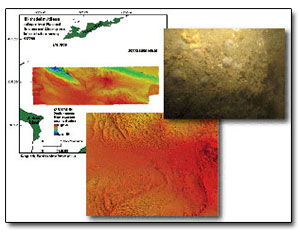 Abstract Abstract
Multibeam-echosounder data, collected during survey H12299 by the National Oceanic and Atmospheric Administration in a 162-square-kilometer area of Block Island Sound, northeast of Gardiners Island, New York, are used along with sediment samples and bottom photography, collected at 37 stations in this area by the U.S. Geological Survey during cruise 2013-005-FA, to interpret sea-floor features and sedimentary environments. These data and interpretations provide important base maps for future studies of the sea floor, focused, for example, on benthic ecology and resource management. The features and sedimentary environments on the sea floor are products of the glacial history and modern tidal regime. Features include bedforms such as sand waves and megaripples, boulders, a large current-scoured depression, exposed glaciolacustrine sediments, and areas of modern marine sediment. Sand covers much of the study area and is often in the form of sand waves and megaripples, which indicate environments characterized by coarse-grained bedload transport. Boulders and gravelly lag deposits, which indicate environments of erosion or nondeposition, are found off the coast of Gardiners Island and on bathymetric highs, probably marking areas where deposits associated with recessional ice-front positions, the northern flank of the terminal moraine, or coastal-plain sediments covered with basal till are exposed. Bottom photographs and video of boulders show that they are commonly covered with sessile fauna. Strong tidal currents have produced the deep scour depression along the northwestern edge of the study area. The eastern side of this depression is armored with a gravel lag. Sea-floor areas characterized by modern marine sediments appear featureless at the 2-meter resolution of the bathymetry and flat to current rippled in the photography. These modern environments are indicative of sediment sorting and reworking.
|
First posted August 27, 2014
Part or all of this report is presented in Portable Document Format (PDF). For best results viewing and printing PDF documents, it is recommended that you download the documents to your computer and open them with Adobe Reader. PDF documents opened from your browser may not display or print as intended. Download the latest version of Adobe Reader, free of charge. More information about viewing, downloading, and printing report files can be found here.
|